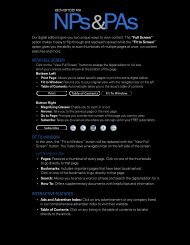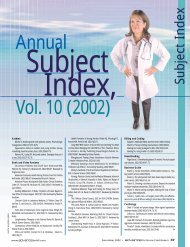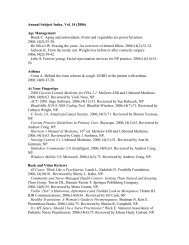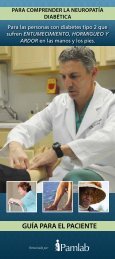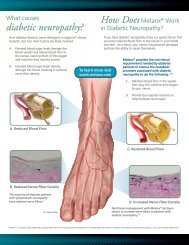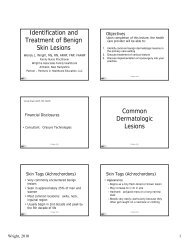View Full Screen - ADVANCE for NPs & PAs
View Full Screen - ADVANCE for NPs & PAs
View Full Screen - ADVANCE for NPs & PAs
Create successful ePaper yourself
Turn your PDF publications into a flip-book with our unique Google optimized e-Paper software.
Diabetes<br />
and he had already eaten a meal, this<br />
data could not be used to appropriately<br />
calculate his subcutaneous insulin needs.<br />
Two protocols were available: the sliding<br />
scale insulin protocol (Table 2) and<br />
the basal–bolus insulin protocol (Table<br />
3). The hospitalist physician decided to<br />
place William on the sliding scale insulin<br />
protocol. After 4 more hours on this<br />
protocol and another meal, the patient’s<br />
glucose level increased to 450 mg/dL.<br />
Table 1<br />
DKA Insulin Infusion Protocol<br />
Serum ketones were negative. The patient<br />
was returned to the insulin infusion, but<br />
this time he was placed on a general medical<br />
unit insulin infusion protocol that<br />
allowed <strong>for</strong> a higher number of units based<br />
on the results of finger sticks per<strong>for</strong>med<br />
every 2 hours.<br />
After another 4 hours, William’s blood<br />
sugars were in the 180 mg/dL range. The<br />
nursing staff calculated subcutaneous<br />
insulin doses based on insulin infusion<br />
1. Call provider be<strong>for</strong>e any of these orders are instituted.<br />
2. Draw STAT basic metabolic panel, magnesium, phosphorus, serum acetone (if not yet<br />
drawn).<br />
3. Discontinue all previous insulin orders.<br />
4. Give bolus human regular insulin IV ___________ units. Suggested dose 0.1 units/kg.<br />
5. Start infusion of 150 units of human regular insulin in 150 mL 0.9% NaCl (1 unit per<br />
mL) at appropriate insulin infusion rate. (See infusion orders below.) Run first 10–20 mL<br />
of infusion through tubing and waste.<br />
Insulin Infusion Protocol:<br />
CAPILLARY or BLOOD GLUCOSE INSULIN INFUSION<br />
> 500 14 mL/hr (14 units/hr)<br />
401–500 10 mL/hr (10 units/hr)<br />
351–400 8 mL/hr (8 units/hr)<br />
301–350 6 mL/hr (6 units/hr)<br />
251–300 4 mL/hr (4 units/hr)<br />
201–250 3 mL/hr (3 units/hr)<br />
151–200 2 mL/hr (2 units/hr)<br />
100–150 1 mL/hr (1 unit/hr)<br />
< 100 no insulin<br />
6. Capillary or blood glucose every hour. Record on glucose monitoring record. Adjust<br />
insulin infusion based on Insulin Infusion Protocol.<br />
7. If insulin infusion is interrupted due to glucose < 100 mg/dL, obtain capillary or blood<br />
glucose every hour until glucose > 100 mg/dL, then restart insulin infusion.<br />
8. Start IV fluids: _________________________ at __________ mL/hr.<br />
9. For signs of hypoglycemia:<br />
A. Collect STAT capillary or blood glucose. If < 60 mg/dL and symptomatic, stop insulin<br />
infusion and give dextrose 25 g IV (50 mL of D50W).<br />
B. Collect STAT capillary or blood glucose. If blood glucose < 60 mg/dL and the patient is<br />
asymptomatic, stop insulin infusion and give dextrose 12.5 g IV (25 mL of D50W).<br />
C. Recheck capillary or blood glucose in 15–20 minutes. If blood glucose < 60 mg/dL,<br />
repeat above procedure A or B depending on patient’s symptoms and contact physician.<br />
10. When the capillary or blood glucose is less than 300 mg/dL, change IV fluids to D5W<br />
______at ______mL/hr.<br />
Consider discontinuing IV fluids when tolerating by mouth diet.<br />
11. Ask provider about frequency of lab draw:<br />
Electrolyte panel every ______________ Phosphate every ______________<br />
Basic metabolic panel every __________ Serum acetone every ___________<br />
Potassium every ________________ Arterial blood gasses every __________________<br />
Magnesium every _______________ Other: ____________every _______<br />
12. Be<strong>for</strong>e stopping insulin infusion, call provider <strong>for</strong> subcutaneous insulin orders (must<br />
be given 30–60 minutes be<strong>for</strong>e insulin infusion is discontinued).<br />
Provider Signature/ID No: _____________________________________________<br />
Date/Time: __________________<br />
rates over the previous 4 hours, and the<br />
hospitalist physician started the patient<br />
on the basal–bolus insulin protocol. The<br />
nursing staff provided instruction about<br />
blood glucose self-monitoring and insulin<br />
administration, and the hospital provided<br />
a blood glucose meter <strong>for</strong> home use. The<br />
nurses instructed William to check his<br />
blood sugars three times per day and to<br />
bring his meter to the follow-up appointment<br />
with his primary care provider<br />
so that his doses could continue to be<br />
adjusted. He was discharged later that<br />
evening with a blood sugar of 203 mg/dL.<br />
Background<br />
Hospitalized patients with hyperglycemia<br />
are usually categorized as being previously<br />
diagnosed with diabetes, having unrecognized<br />
diabetes, or having hyperglycemia<br />
related to hospitalization. Hyperglycemia<br />
with and without diabetes has been associated<br />
with poor outcomes such as longer<br />
lengths of stay. 1 The American College<br />
of Endocrinologists recommends that<br />
elevated glucose levels (> 140 mg/dL in<br />
patients who are not critically ill) should<br />
be identified in all hospitalized patients<br />
and should be treated aggressively and<br />
as soon as detected. 2<br />
Previously diagnosed diabetes usually<br />
falls into two categories: type 1 (presenting<br />
as diabetic ketoacidosis; DKA)<br />
or type 2 (presenting as hyperosmolar<br />
hyperglycemia state; HHS). The diagnosis<br />
of diabetes has become more complex.<br />
The presentation can be misleading due<br />
to conflicting physical and objective findings.<br />
Often this leads to inappropriate<br />
treatment that produces poor outcomes,<br />
such as immunosuppression, endothelial<br />
dysfunction, inflammation, increased<br />
oxidative stress or thrombosis. 1<br />
William presented to the emergency<br />
department with symptoms similar to<br />
those of someone with type 1 diabetes<br />
(abrupt onset of symptoms and lack of<br />
family history of diabetes). He also had<br />
positive serum ketones, a status typically<br />
present in type 1 diabetes. These<br />
symptoms can also be present in type<br />
2 diabetes, as in HHS. This patient did<br />
not fit the typical physical presentation<br />
of type 1 diabetes. He was an obese black<br />
man with acanthosis nigricans, a condition<br />
often found in type 2 diabetes.<br />
26 <strong>ADVANCE</strong> <strong>for</strong> NP & <strong>PAs</strong>



